“Belén District is one of thirteen districts of the Maynas Province. Belen (spanish for “Bethlehem”) exists at the edge of Iquitos, in the floodplain of the Itaya River (a tributary of the Amazon), and consists of 65,000 inhabitants, most of them poor, and many of whom live in extreme poverty, without electricity, none with clean water or sanitation. There also exists an estimated 60,000 people living across the river in outlying areas, also with no electricity, water and sanitation. Most homes will float or are built on stilts, as the river floods some 5-6 meters during February through July. Belen, a unique world community, has been referred to, in travel books, as the “Venice of Latin America”. In Pueblo Libre, a section of Belen on the waterfront, an estimated 14000 people, 30% under age 12, live in a busy river port, where charcoal, bananas, fish, and other goods are brought, mostly by canoe, to be distributed and sold throughout Belen. People there live in overcrowded conditions (90% of homes house 2 or more families; some homes as many as 5) and, in addition to malaria, dengue fever, water-borne illnesses, respiratory illnesses, tuberculosis, and HIV, there are problems associated with severe poverty; alcoholism, crime, prostitution, unemployment, child abuse and domestic violence. Years of deteriorating conditions in Belen have resulted in widespread frustration and hopelessness among Belen residents. Literacy is estimated at 30%.” – Wikipedia
There’s not much more to be said about visiting the Belén Market – it’s noisy, crowded, filled with sights and smells both good and bad. It’s definitely a place to visit if you’re in Iquitos, but it’s best to visit with someone who knows the market as you could easily get lost (the market is roughly six by twenty city blocks in area), and pickpocketing and muggings are apparently pretty commmon. We had both our tour guide, who shows up early on in these photos, as well as a market guard, who followed us at a discreet ten feet or so, darting in every now and again if someone he didn’t like the looks of seemed to be getting too close to us. We’d planned a Spanish language tour, and at last minute three young women, one from Latvia and two from Canada, joined the tour, but wanted it in English, which became a little frustrating since we’d planned this weeks ago and it took a bit to get our guide to lead bilingually, so that Henry could understand it all. That, and the two Canadian women, apparently lacking any concept of time or interest in the rest of us, had just sat down to breakfast at 9 a.m. when the tour was supposed to start and took a solid 45 minutes before they were ready to go while the rest of us stood around – not an apology or acknowledgement from either of them, and then during the tour they kept wandering off, leaving the guide to have to keep going and finding them. Some people are just a little too self-important, especially for 20-something recent college grads. One can only guess that they’ve led a bit of a sheltered and privileged life – but, who knows, that’s just an assumption.
The rest, in photos, of which I took hundreds, so I’ve picked out thirty that I particularly liked.
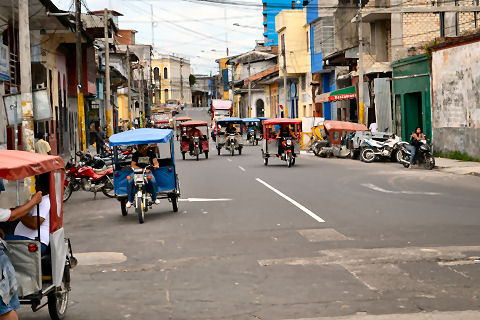
The market is about 6 blocks from our hotel.
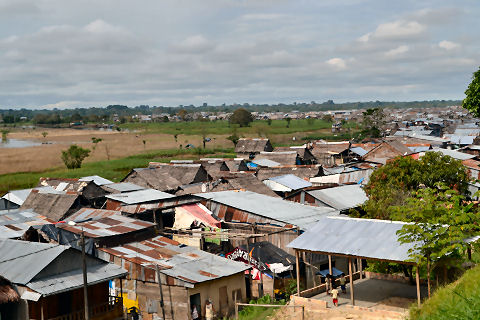
This is the lower Belén, residential mostly, in the flood plain.
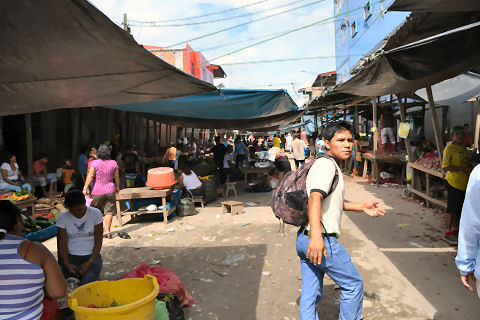
Entering the market with our guide, Billy.
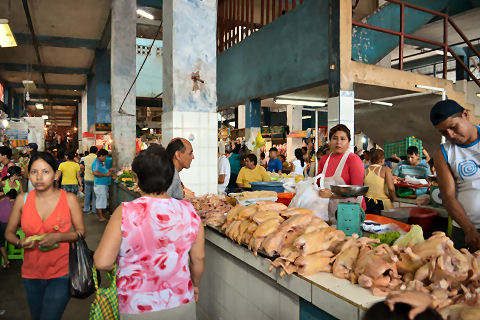
Some of the market is indoors, some out.
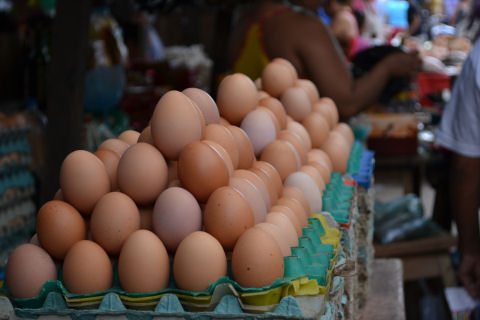
Presentation is everything.
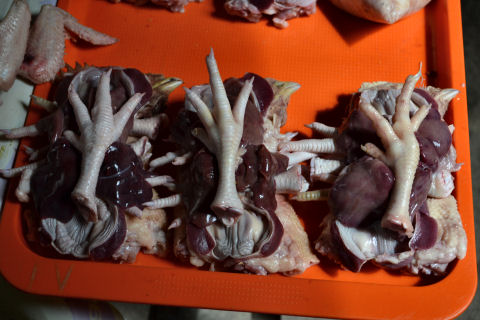
Really, it is.
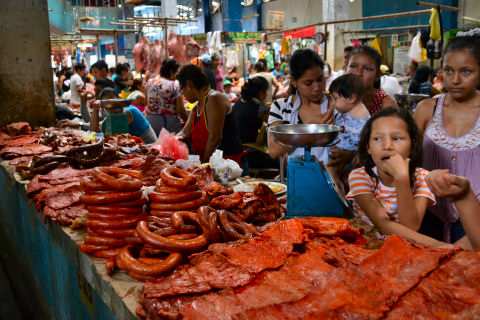
It’s chaos. Those flat bright red meat cuts are the cecina I mentioned in the last post – marinated pork flank.
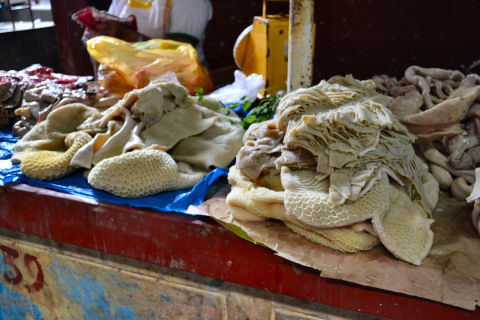
Different tripes.
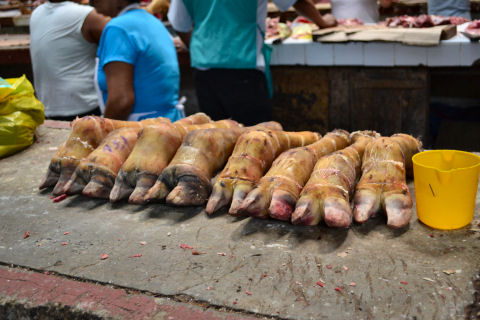
Cow’s foot, anyone?
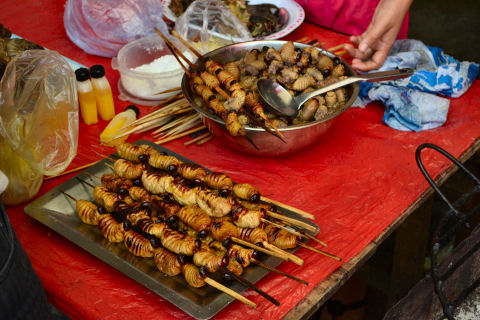
More suri grubs. Didn’t try them again.
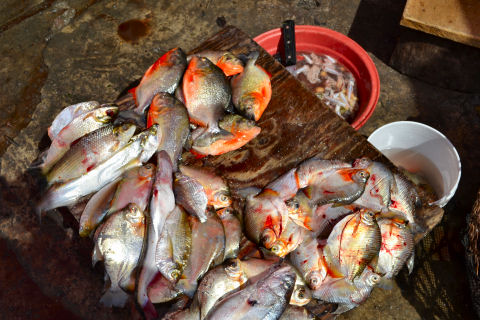
Piranha in the back, palometa in the front.
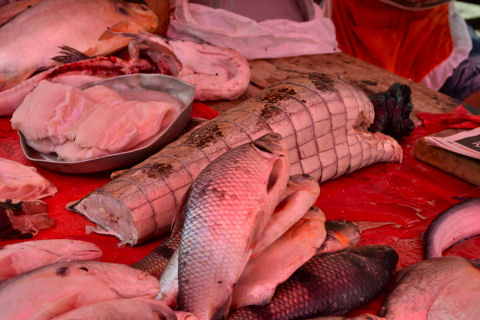
Alligator in the middle.
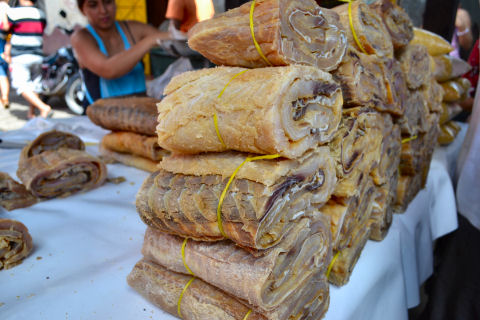
Remember the huge white fish, paiche, we tried in Lima? Here they semi-dry it and roll it up in bundles to sell. It would have been cool to see one whole, but they were already “butchered” by the time we got there. What else do you do with a seven foot, two hundred and some pound fish?
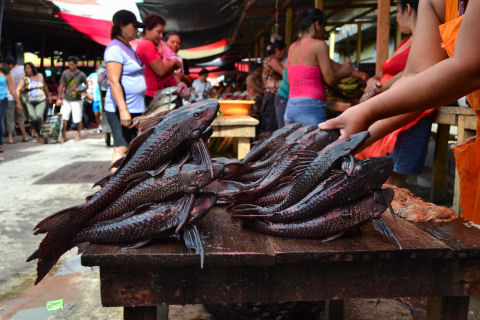
“Mostly bones, used for making stock” seemed to be the advice of the day. They’re still alive sitting here, they can live out of the water for 2-3 days. I suppose at least you know they’re fresh when they start to try to wander away on their fins. Locally known as carachama, a type of armored catfish.
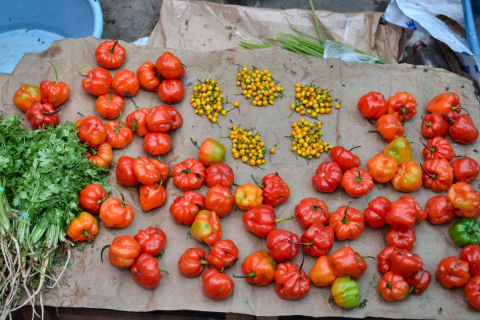
The big ones are actually sweet chilies. The little yellow ones, ají charapa, are fiery hot and oh so good.
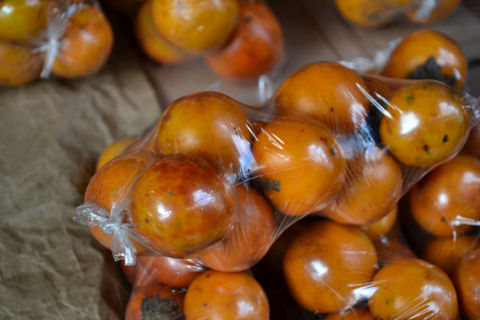
Cocona – tasting somewhere between a lemon and a tomato and used as the base for many sauces here.
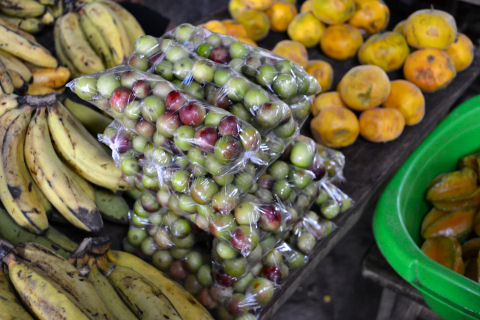
Camu-camu – very acidic, high in vitamin C fruit – really not a traditional foodstuff as they pretty much need to be sweetened and blended they’re so acidic.
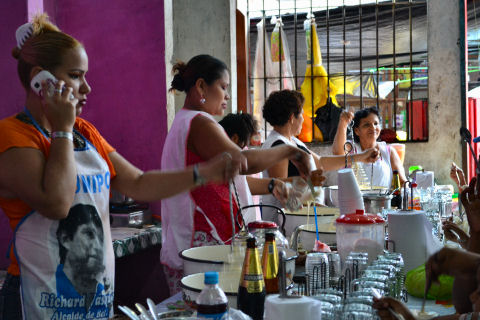
Making ponche in between phone calls – a sort of eggnog made by a steady beating of eggs and sugar until it’s light and foamy and then adding either beer or tea to it to make a drink.
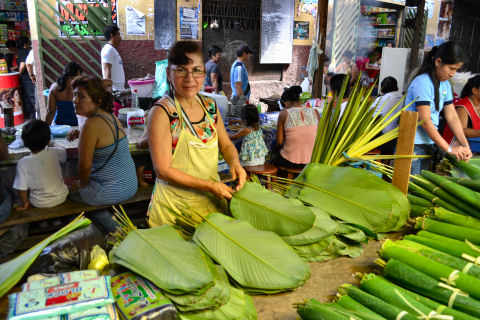
Prepping bijao leaves.
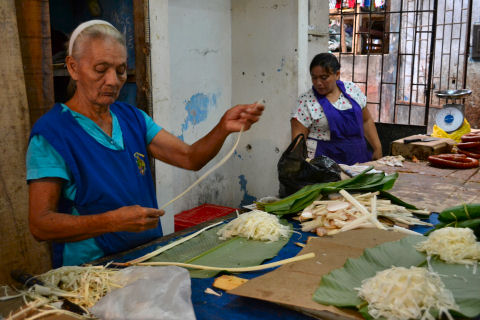
And cutting heart of palm into long thin threads, the common way of serving fresh palmito here.
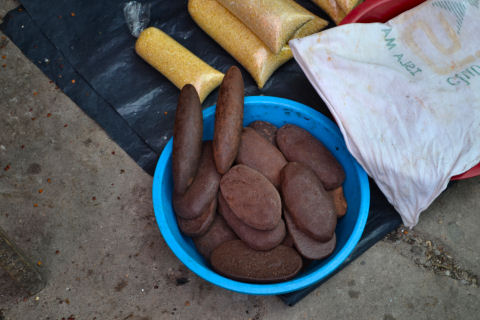
Cocoa. We bought some.
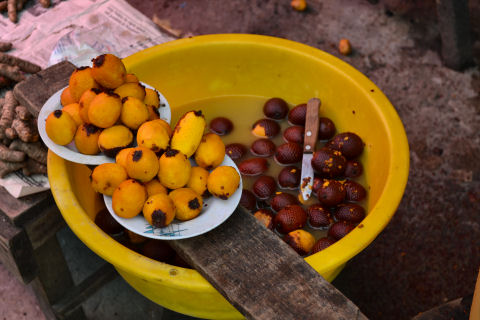
Aguaje palm fruit, you peel off the very attractive red scales and then eat the thin layer of yellow pulp that surrounds a seed which takes up the majority of the volume.
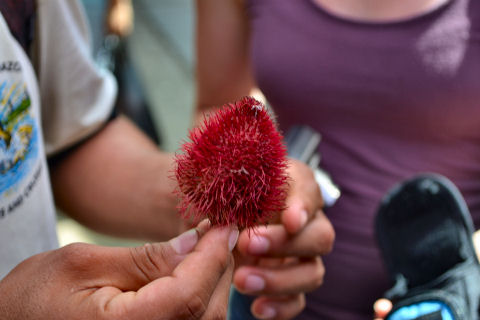
Achiote (or annatto) seed pods. The saffron of the Amazon.
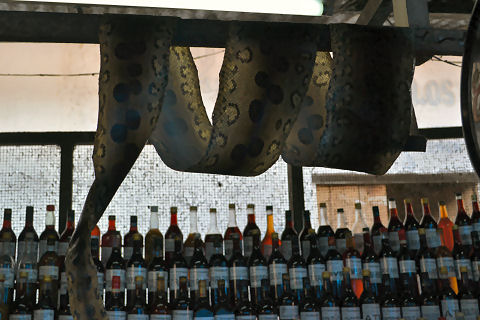
It’s not all food, you can buy yourself an anaconda skin if you like. And more “tonics” than you can shake a stick at, for every malady known to man, or at least man in the Amazon.
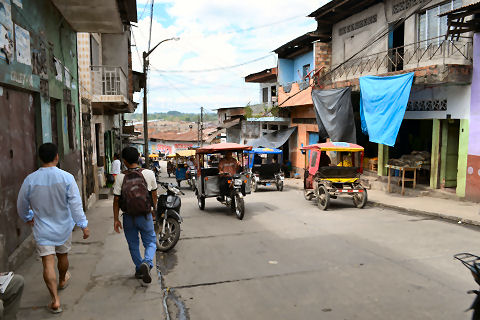
Heading down into the lower Belén, more or less out of the market proper, headed for the river.
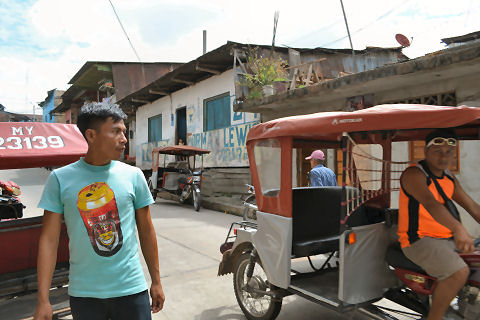
Our guardian follows.
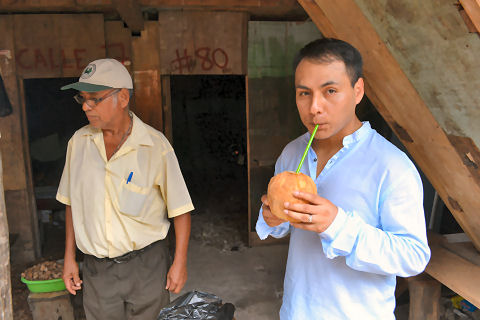
We stop for some fresh coconut milk amd Brazil nuts to refresh ourselves.
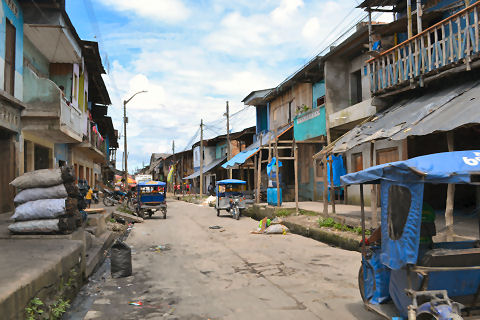
“Venice” street. From December to March the river rises anywhere from 3 to 6 meters and fills the lower levels of this residential area with water. Everyone simply moves their residences and shops upstairs, uses canoes to get around, and await the return to normal water levels.
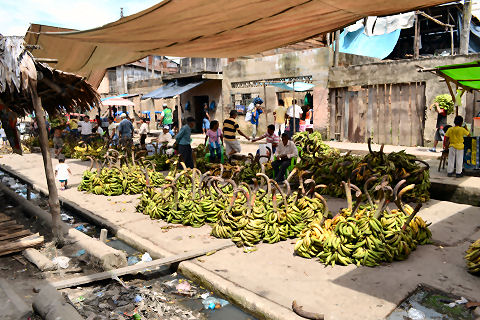
Bananas and plantains everywhere.
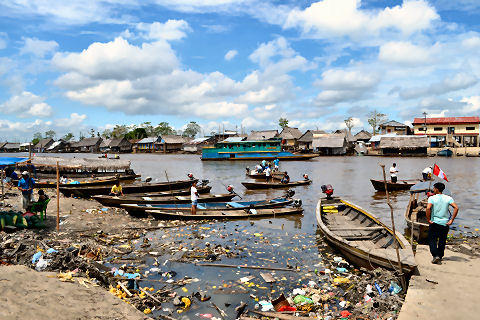
Our guardian goes to arrange a small boat for us to tour the very contaminated Itaya river.
More soon.
Great pictures Dan
[…] paiche, the monster fish of the Amazon – remember our visit to the paiche farm? Or the Belén market? Served over a buttery cauliflower puree and topped with a brunoise of carrots and some baby […]